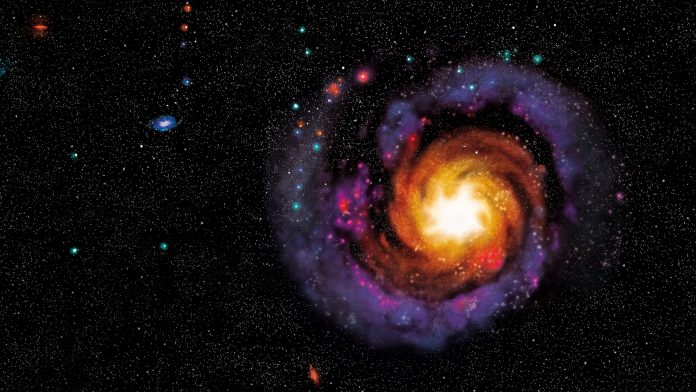Researchers at the National Astronomical Observatory of Japan (NAOJ) have examined data obtained with the Atacama Large Millimeter/submillimeter Array (ALMA) and discovered an ancient galaxy with a spiral morphology by only 1.4 billion years after the Big Bang.
This groundbreaking finding is the most ancient galaxy of its kind every observed and the discovery of a galaxy with a spiral structure at such an early stage is crucial evidence in being able to resolve the long unanswered question of astronomy: “How and when did spiral galaxies form?”
“I was excited because I had never seen such clear evidence of a rotating disk, spiral structure, and centralised mass structure in a distant galaxy in any previous literature,” said Takafumi Tsukui, a graduate student at SOKENDAI and the lead author of the research paper published in the journal Science. “The quality of the ALMA data was so good that I was able to see so much detail that I thought it was a nearby galaxy.”
Spiral galaxies, such as the Milky Way, are essential objects in the Universe, accounting for up to 70% of the number of galaxies in the Universe. Interestingly, some research has indicated that the ratio of spiral galaxies decreases quickly when looking back through the history of the Universe. This, therefore, raises the question of when exactly the spiral galaxies were formed.
Tsukui, together with Satoru Iguchi, his supervisor and professor at SOKEDAI and NAOJ observed a galaxy called BRI 1335-0417 in the ALMA Science Archive. This galaxy existed 12.4 billion years ago and contained a big quantity of dust, which obscures the starlight, thus making it challenging to examine the galaxy precisely and with visible light.
However, ALMA can identify radio emissions from carbon ions in the galaxy, which allows researchers to examine exactly what is happening in the galaxy.
They discovered a spiral structure expanding 15,000 light-years from the centre of the galaxy, one third of the size of the Milky Way, while the approximate total mass of the stars and interstellar matter in BRI 1335-0417 is equivalent to that of the Milky Way.
“As BRI 1335-0417 is a very distant object, we might not be able to see the true edge of the galaxy in this observation,” explained Tsukui. “For a galaxy that existed in the early Universe, BRI 1335-0417 was a giant.”
With this knowledge, another question emerges: how was this distinctive spiral structure established in only 1.4 billion years after the Big Bang? The scientists contemplated numerous potential causes and indicated that it could be as a result of an interaction with a small galaxy.
BRI 1335-0417 is actively forming stars and the researchers discovered that the gas in the outer part of the galaxy is gravitationally unstable, which is conducive to star formation. This situation is likely to arise when a significant amount of gas is delivered from elsewhere, perhaps as a result of collisions with smaller galaxies.
Galaxies that have large amounts of dust and actively produce stars in the ancient Universe are considered to be the ancestors of the giant elliptical galaxies in the present Universe. In that case, BRI 1335-0417 shifts its shape from a disk galaxy to an elliptical one in the future. Or, contrary to the conventional view, the galaxy may remain a spiral galaxy for a long time. BRI 1335-0417 will play an integral part in the study of galaxy shape evolution over the long history of the Universe.
“Our Solar System is located in one of the spiral arms of the Milky Way,” added Iguchi. “Tracing the roots of spiral structure will provide us with clues to the environment in which the Solar System was born. I hope that this research will further advance our understanding of the formation history of galaxies.”









